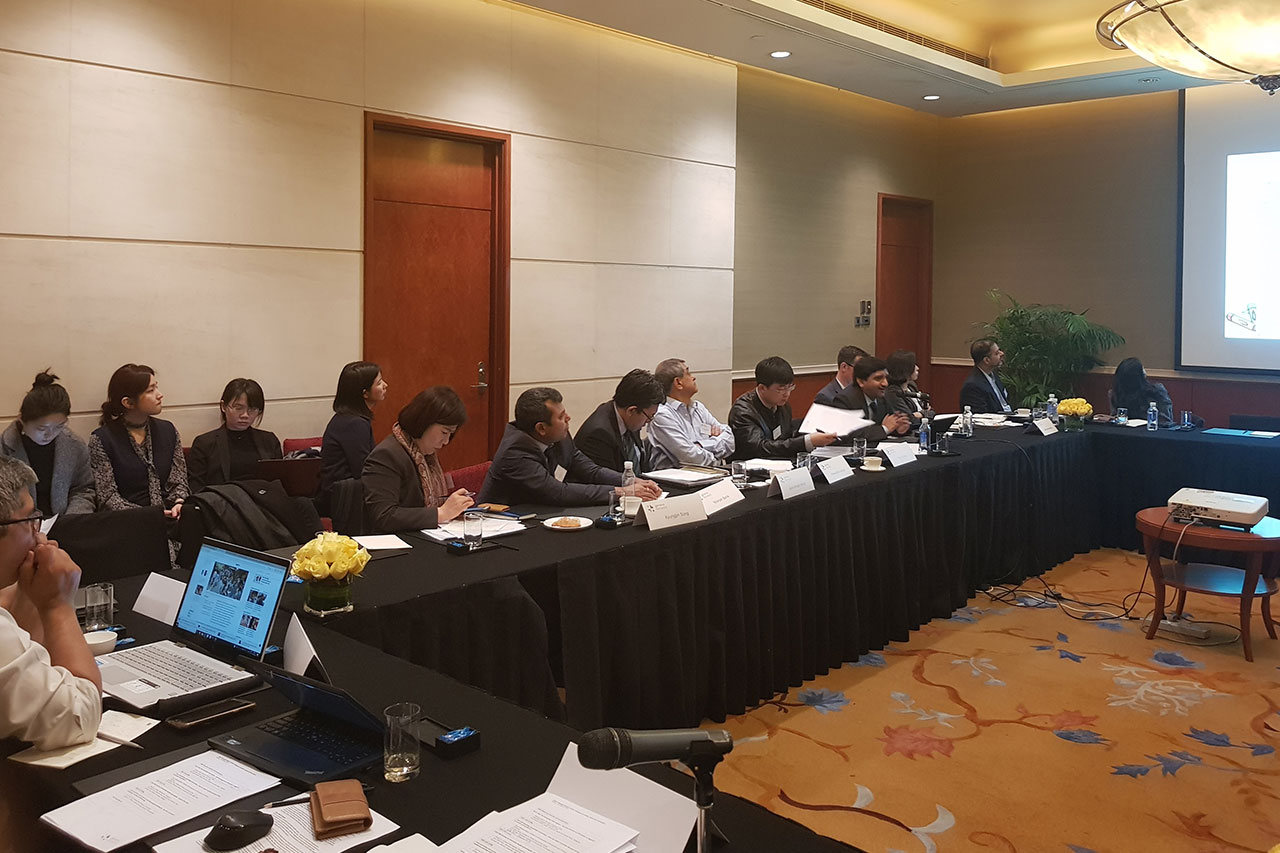Asian thought leaders meet in Beijing to talk innovation, trade and health policy
Many Asian countries are increasingly looking to the knowledge economy to complete the transition from middle-income to high income status.
What are the policies that drive innovation and how are Asian countries faring? How will the need for more innovation impact the Asian trade regime? And how can Asian countries ensure their people have access to innovation, particularly healthcare?
On 15th March in Beijing, Geneva Network assembled 15 thought leaders from around Asia to examine these and other important questions.
The emerging trade regime – will Asia be an IPR leader or laggard?
Nilanjan Banik, professor of economics at India’s Bennett University highlighted the journey India is currently undertaking from imitation to innovation. A historic lack of protection for intellectual property rights allowed India to establish itself as a leader of medicine exports in terms of volume, but has left it falling well behind in terms of global value. Meanwhile, significant shortcomings in health infrastructure and financing have left few people able to access the generic medicines manufactured in India.
An increasing domestic constituency of innovators, coupled with the government’s desire for more FDI, point to a future where India’s IP framework will have to undergo constant modernisation in order to compete with those countries where IP standards are higher.
However, the Indian pharmaceutical industry has started the process of upgrading its innovative capacity, largely through joint partnerships with foreign companies, he noted. A more hospitable IP environment since 2005 is partly responsible. An increasing domestic constituency of innovators, coupled with the government’s desire for more FDI, point to a future where India’s IP framework will have to undergo constant modernisation in order to compete with those countries where IP standards are higher.
As knowledge-based industries increase in economic importance, a country’s IP environment increasingly determines its competitiveness, according to Azrul Mohd Khalib from Malaysia’s Galen Centre for Health and Social Policy. Since 2012 Malaysia has been making genuine progress in this regard, but the recent issue of a Government Use License for a Hepatitis C medicine gives cause for concern. Such an abrogation of property rights creates uncertainty, and may undermine key sources of investment on which the country is relying to help it graduate to High Income status – particularly in the area of clinical trials, biopharmaceutical manufacturing and of course other non-health knowledge sectors.
The growing importance of vaccination means that IP management for these complex products will become a central issue for both payers and biopharmaceutical companies
Prabuddha Ganguli of Vision IPR noted the many IP issues facing innovators in Asia, particularly in the health sector. Governments’ preoccupation with medicine affordability and access is adding to pressures on companies to develop new pricing and business models, many of which rely on IP. The growing importance of vaccination means that IP management for these complex products will become a central issue for both payers and biopharmaceutical companies, according to Dr Ganguli. And IP licensing and collaboration with local stakeholders will become more important as international companies look to increase access to their products in middle and lower-income countries.
How can Asian countries develop strong innovation ecosystems?
According to Kyungjin Song of Korea’s Institute for Global Economics, innovation is absolutely central to future economic prosperity, especially given the demographic challenges facing her country. It is concerning, then, that Korea’s relative innovation performance has been steadily declining according to several international indices. This under-performance continues in the face of a number of government measures to improve innovation, including more R&D investment, regulatory reforms, tax incentives and even placing entrepreneurship in the school curriculum. The key to future success, she argued, is to reduce the myriad regulatory barriers to innovation that are holding back Korea.
China’s performance in innovation has been impressive in recent years, by contrast. Tian Giuchao from Shanghai’s Institute of Science and Technology Policy laid out the regulatory, tax and labour reforms that have allowed Shanghai in particular to emerge as an Asian innovation powerhouse. China is not resting on its laurels, but has the target of becoming a global “innovation power” by 2050, with a first mover advantage in a number of technology areas including Artificial Intelligence.
Future economic growth will not come from traditional sectors like heavy manufacturing and agriculture but rather from knowledge-intensive sectors that can contribute to economic value-addition and productivity enhancement.
Berly Martawardaya of Indonesia’s Institute for Development Economics and Finance (INDEF) emphasised the importance of knowledge-based sectors to Indonesia’s quest to escape the middle-income trap. Future economic growth will not come from Indonesia’s traditional sectors like heavy manufacturing and agriculture, he noted, but rather from knowledge-intensive sectors that can contribute to economic value-addition and productivity enhancement. While there are some encouraging early signs that the government recognises this, the country lacks a coherent innovation policy framework, while recent reforms to the country’s patent law include overly broad limitations and exceptions that could undermine investment, he concluded.
Access to innovative health technologies – lessons from Asia
Many Asian countries are in the process of instituting reforms to their healthcare systems which aim to provide coverage to the majority of people. This important development will see many people covered for basic primary health care services for the first time. However, as these reforms bed in and prosperity increases, people will be demanding access to more than a basic package of primary care services.
Innovative models of health insurance are emerging, with new, non-traditional players entering the market.
Chang Liu of pan-Asian NGO Access International set out the remarkable innovations that are occurring in healthcare insurance and delivery that are happening in Asia alongside the governmental focus on basic universal health coverage. Innovative models of health insurance are emerging, with new, non-traditional players entering the market. Some of these are aiming to disrupt the traditional agent and broker model, with new online only providers now becoming common. Some focus on specific disease areas and sub populations, while other groups are experimenting by including preventative services in their coverage. Others are investing in data analytics to get a better picture of their risk pool. Thanks to this experimentation, Asia is pulling ahead of Europe and the United States on health insurance innovation; in those two continents, the dominance of the public sector and broad mandates are dampening competition, experimentation while entrenching existing large players.
As part of their universal access reforms, Asian governments have a continuous weather eye on the value of medicines, noted Kenneth Lee of Malaysia’s Monash University. Governments need to be sure that a medicine delivers benefits that justify its cost before a government can commit to making it available to everyone. As such Health Technology Assessment is becoming a more common feature of the health landscape, to provide an economic basis for reimbursement decisions. Some countries, however, struggle to ensure timely access to innovative medicines due to burdensome regulatory requirements, with Chinese patients particularly suffering in this regard.
While India boasts innovative healthcare services of the highest quality, unfortunately these are only available to the lucky few, according to Maulana Azad National Urdu University’s Amir Ullah Khan. Access to even primary healthcare is very limited, government health expenditures are declining and tragic but avoidable incidents are all too common – as in the recent case where a number of children died in hospital due to a lack of oxygen cylinders. There is an unfortunate popular sentiment that high prices, driven by multinational companies, are to blame, even though the problems run much deeper. This has led to self-defeating policies such as price controls, which have exacerbated significant supply chain problems and the high prevalence of fake and substandard medicines.
There is an unfortunate popular sentiment that high prices, driven by multinational companies, are to blame, even though the problems run much deeper.
Grounds for optimism?
Within a lifetime, Asia has transformed itself from a patchwork of largely agrarian economies to an increasingly integrated and outward-looking emerging economic power. Citizens in the continent are growing more prosperous and empowered, and are naturally looking to provide for their health beyond basic primary care. At the same time, governments are looking for new sources of growth particularly in knowledge-based sectors. As Asia develops further, innovation will be central.
[/av_textblock]



